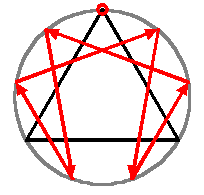The Enneagram is a figure that has been used to model all sorts of things. Most current books on the Enneagram are about a personality model developed from some of the work of Oscar Ichazo of Arica Institute, Chile. Claudio Naranjo was instrumental in bringing his take on Ichazo’s work out of Chile. Many Jesuits picked up the ideas and wrote books, as did others. There may be hundreds of titles by now.
There’s a similar application of the Enneagram, but to body types. Rodney Collin is a source for these ideas. Joel Friedlander and Susan Zannos have written books on this version of the Enneagram.
Another application of the Enneagram is as part of a pantheon of systems – from monads, dyads and triads through to larger systems. John Godolphin (J. G.) Bennett was key in developing these ideas and their application to life situations. He used the term Systematics (also used in Biology, but with a different meaning). Two of his books that are relevant are Elementary Systematics / A Tool for Understanding Wholes and Enneagram Studies. Bennett had ties to Gurdjieff, who introduced the Enneagram to his students.
Bennett’s ideas on Systematics have been applied in business situations. See Saul Kuchinsky’s Systematics / Search for Miraculous Mangement and Richard Knowles’ The Leadership Dance / Pathways To Extraordinary Organizational Effectiveness. Go to www.centerforselforganizingleadership.com/ to contact Richard and his wife. Tell them I sent you.
Here’s a picture of the Enneagram, with a red circle at the top that I added to fit it into the N-Gram diagrams I developed. The Enneagram is based on the patterns of repeating digits in base ten for n/7 (.00, .142857, .99) – the red arrows and circle, and n/3 (.00, .33, .66, .99) – the black triangle. Paired N-Grams are similar to the Enneagram in that the two divisors added together equal the base being used. If neither divisor has any prime in common with the base, then the combined patterns express fully in the number base – and touch every point around the circle once, save the top point which both patterns have in common. The Enneagram is also one of the smaller set of Second Power N-Grams, for which the square of the smaller divisor plus one is the number base. In this sequence, the overall patterns formed by the larger divisor are built out of six-point moving patterns, and in every third figure, one two-point moving figure. I explore this further elsewhere.

The Gurdjieff/Bennett Enneagram is used to model a process of transformation. The sequential steps are mapped clockwise around the circle, starting and ending at the top. A mental approach consistent with the transformation follows the 1-4-2-8-5-7 pattern. Applying the model requires identifying the anchor points (3, 6, 0/9), the intervening steps, and the relevant interrelationships. The process of attempting to use the model as a map can bring clarity to that which is being explored.

